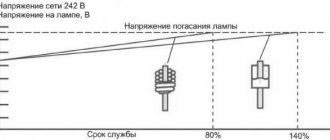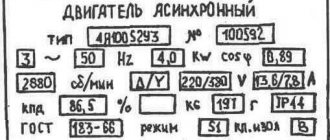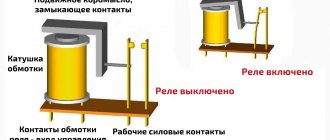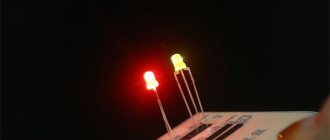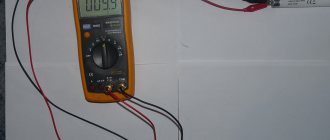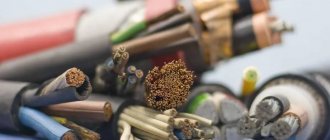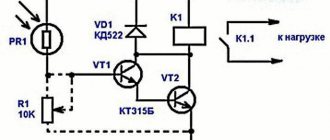A fluorescent lamp (FL) is a light source created by an electrical discharge in an environment of mercury vapor and inert gas. In this case, an invisible ultraviolet glow appears, acting on the phosphor layer applied from the inside to the glass flask. A typical circuit for switching on a fluorescent lamp is a ballast with an electromagnetic ballast (EMB).
Design and description of LL
The bulb of most lamps has always had a cylindrical shape, but now it can be in the form of a complex figure. At the ends, electrodes are built into it, structurally similar to some spirals of incandescent lamps made of tungsten. They are soldered to the pins located outside, to which voltage is applied.
The gas conductive medium inside the LL has negative resistance. It manifests itself in a decrease in voltage between opposite electrodes with an increase in current, which must be limited. The circuit for switching on a fluorescent lamp contains a ballast (choke), the main purpose of which is to create a large voltage pulse to ignite it. In addition to it, the EMPR includes a starter - a glow discharge lamp with two electrodes placed inside it in an inert gas environment. One of them is made of a bimetallic plate. In the initial state, the electrodes are open.
How it works?
The working process of DRL 250 lamps, the characteristics of which are ideal for use in industrial premises, comes down to the following points.
After the supply voltage is applied, it bypasses the base and flows to the electrodes, and this, in turn, ensures the occurrence of a glow discharge. As a result, free electrons and positive ions are formed in the flask. After some time, when the number of charge carriers reaches a certain critical point, the glow discharge transforms into an arc discharge. Often, from the moment of switching on to the occurrence of a stable arc discharge occurs within one minute. It is worth noting that the distance between the electrodes is very small, so gas ionization in this gap occurs quite easily.
Operating principle of LL
The starter circuit for turning on fluorescent lamps works as follows.
- Voltage is applied to the circuit, but at first no current flows through the LL due to the high resistance of the medium. Current passes through the spirals of the cathodes and heats them up. In addition, it also goes to the starter, for which the supplied voltage is sufficient to create a glow discharge inside.
- When the starter contacts heat up from the passing current, the bimetallic plate closes. After this, the metal becomes a conductor and the discharge stops.
- The bimetallic electrode cools down and opens the contact. In this case, the inductor produces a high voltage pulse due to self-induction, and the LL lights up.
- A current flows through the lamp, which then decreases by a factor of 2 as the voltage across the inductor drops. It is not enough to restart the starter, the contacts of which remain open when the LL is burning.
The connection diagram for two fluorescent lamps installed in one luminaire provides for the use of one common choke for them. They are connected in series, but each lamp has one parallel starter.
The disadvantage of the lamp is that the second lamp turns off if one of them fails.
Important! Special switches must be used with fluorescent lamps. Budget devices have high starting currents, and the contacts can stick.
Checking and repairing lamps
If the lamp burns out, it is very difficult to repair it, but it is still quite possible. First you need to find out what exactly is the malfunction. To do this, check the throttle of the fluorescent lamps. An incandescent test light must be used. Connect two wires from the contacts to the test socket, and plug the structure into the network. If the starter is intact, then the control model begins to heat at full strength, sometimes it shorts out a little.
If necessary, you can also repair the lamp choke, but then you need to pay attention to the power of the daylight device, the emission spectrum and the size of the wires (their cross-section). If you connect inappropriate parts, it will not burn.
In the event of a complete malfunction, you can always buy new fluorescent lamps, especially since their price is often quite affordable. Sales are carried out in any electrical equipment and components stores. Particularly popular are the Chinese Osram and Philips, as well as domestic electronic ballasts and OKPD. When purchasing, always pay attention to the technical characteristics of the selected models, as well as their energy consumption.
How to start a LL with electronic ballasts
Chokeless switching of fluorescent lamps is carried out through an electronic unit in which a sequential change in voltage is formed when they are ignited.
Advantages of the electronic launch circuit:
- possibility of starting with any time delay;
- no need for a massive electromagnetic throttle and starter;
- no humming or flickering of lamps;
- high light output;
- lightness and compactness of the device;
- longer service life.
Modern electronic ballasts have compact sizes and low energy consumption. They are called drivers, placed in the base of a small lamp. Chokeless switching of fluorescent lamps allows the use of conventional standard sockets.
The electronic ballast system converts the 220 V AC mains voltage into high frequency. First, the LL electrodes are heated, and then a high voltage is applied. At high frequencies, efficiency increases and flicker is completely eliminated. The fluorescent lamp switching circuit can provide a cold start or with a smooth increase in brightness. In the first case, the service life of the electrodes is significantly reduced.
Increased voltage in the electronic circuit is created through an oscillatory circuit, leading to resonance and ignition of the lamp. Starting is much easier than in the classic scheme with an electromagnetic choke. Then the voltage is also reduced to the required discharge retention value.
The voltage is rectified by a diode bridge, after which it is smoothed out by a parallel connected capacitor C1. After connecting to the network, capacitor C4 is immediately charged and the dinistor is broken through. The half-bridge generator is started on transformer TR1 and transistors T1 and T2. When the frequency reaches 45-50 kHz, a resonance is created using a series circuit C2, C3, L1 connected to the electrodes, and the lamp lights up. This circuit also has a choke, but with very small dimensions, allowing it to be placed in the lamp base.
The electronic ballast has automatic adjustment to the LL as the characteristics change. After some time, a worn lamp requires an increase in voltage to ignite. In the EPG circuit, it simply will not start, and the electronic ballast adapts to changes in characteristics and thereby allows the device to be operated in favorable conditions.
The advantages of modern electronic ballasts are as follows:
- smooth start;
- efficiency of work;
- preservation of electrodes;
- elimination of flicker;
- performance at low temperatures;
- compactness;
- durability.
The disadvantages are higher cost and complex ignition circuit.
Advantages and disadvantages
Energy-saving gas-discharge fluorescent lamps are models of lighting devices for creating daylight in rooms where there is no sunlight. If incandescent or diode models do not use special gas compounds for combustion, then fluorescent ones emit light due to the reaction of a mixture of gases that are in a flask with a wick.
Photo - fluorescent lamps
Previously, it was believed that such lamps were harmful to vision, and they were rarely used in domestic conditions. In most cases, they were used to equip production premises (warehouses, garages). But special gas mixtures, which include calcium halophosphate, make it possible to produce calm yellow rays that are perfectly perceived by the eye crystals.
fluorescent lamps
- Fluorescent models can provide luminous output that will be much higher than that of incandescent lamps;
- Despite the bright glow, they save energy;
- Lampshades are often made from durable materials that are quite durable. They may not break even if dropped;
- The durability of gas-discharge lamps is many times greater than that of conventional ones;
- At the moment, these lighting devices have a fairly wide color temperature. If previously they were produced exclusively low (the light was bright white), now yellow and natural options can be found on sale.
Flaws:
- Disposal of fluorescent lamps can only be carried out by specialists, or if they are handed over to certain institutions, since the gas mixture contains components dangerous to the body (for example, phosphorus gas or mercury compounds). Unlike their non-gas counterparts, they cannot simply be thrown into the trash, and special workers must be called in to dismantle them;
- Like some LED lamps, the fluorescent fluorescent lamp does not turn on immediately, it blinks for several seconds, and after heating the gas-discharge mixture it turns on completely;
- Can only be inserted into special cartridges;
- Any model hums a little and sometimes blinks during operation;
- It is not always possible to connect a natural daylight lamp with your own hands; an electronic circuit is required. In some cases, a rather serious approach is required to ensure the installation and operation of the lamp. While a simple economical lamp can be screwed into a socket within a few minutes.
There are different types of lighting fixtures. They can be classified by power, temperature and shape. In particular, the most popular now are:
- Linear options (elongated electric model, suitable for lighting corridors or official offices);
- Ring (they are also called round). Ideal for lighting living spaces and kitchens.
Sometimes they are categorized by installation type. For example, there may be portable, hanging and wall-mounted offerings that can be mounted on any surface. Now especially popular is the rechargeable daylight table lamp, which allows you to provide a natural soft glow in any corner of the room.
Photo - use
Application of voltage multipliers
The method makes it possible to turn on the LL without electromagnetic ballast, but is used primarily to extend the life of the lamps. The switching circuit for burnt-out fluorescent lamps allows them to work for some more time if the power does not exceed 20-40 W. In this case, the filaments can be either intact or burnt out. In both cases, the leads of each filament must be short-circuited.
After rectification, the voltage doubles and the lamp lights up instantly. Capacitors C1, C2 are selected for an operating voltage of 600 V. Their disadvantage is their large dimensions. Capacitors C3, C4 are set to mica at 1000 V.
LL is not intended for DC power supply. Over time, mercury accumulates near one of the electrodes, and the glow weakens. To restore it, change the polarity by turning the lamp over. You can install a switch so you don't have to remove it.
How to choose the power of an energy-saving lamp
This lamp starts up instantly, in contrast to the long blinking and flickering of conventional LU and LD models.
What are the disadvantages of this connection scheme? Firstly, the operating current of energy-saving lamps at the same power is lower than that of linear fluorescent lamps. What does this mean?
And the fact is that if you choose a saving equal to or less than the LU power, your card will work with overload and one day will fall apart. To prevent this from happening, the power of energy-efficient boards should ideally be 20% more than that of fluorescent lamps.
That is, for a 36W LDS model, take a single-legged board from 40W and above. And so on depending on the proportions.
If you are converting a single inductance lamp into two lamps, consider the wattage of both.
Why else do you need to take it with a reserve and not select the power of CFLs equal to the power of fluorescent lamps? The fact is that in unnamed and inexpensive CFL lamps, the real power is always an order of magnitude less than the declared one.
Therefore, do not be surprised when, connecting an old Soviet LB-40 lamp, a Chinese housekeeper card for the same 40W, you get a negative result. This is not a scheme that does not work: the quality of the goods of the Celestial Empire does not correspond to the “Soviet guests” made of reinforced concrete.
Starterless circuit for switching on fluorescent lamps
The circuit with a starter requires a long time to warm up the lamp. In addition, it sometimes has to be changed. In this regard, there is another scheme with heating of the electrodes through the secondary windings of the transformer, which also serves as a ballast.
When fluorescent lamps are switched on without a starter, they must be marked RS (quick start). A starter-started lamp is not suitable here, since its electrodes take longer to heat up and the coils will quickly burn out.
Technical characteristics of DRV and DRL lamps
There are models of various powers on the market: 160 W, 250, 500, and occasionally you can find 700 and 1000 W.
Light bulbs available in different wattages
Below is a technical description for DRV 250 lamps (they are used for artificial lighting in greenhouses):
- Lamp length is 22.5 cm, diameter - 9.1 cm;
- Service life - 3000 hours (on average);
- Luminous flux - 4700 lm;
- Light output level - 18.8 lm/W;
- The voltage is 220 W;
- Nominal power level - 250 W;
- An E40 type base is inserted.
You may be interested in this Features of filament lamps
Other models will have different characteristics.
Advantages and negative qualities
What is good and what is bad about DRL 250 lamps? The characteristics of their development provide them with the following positive indicators:
- Very high light output compared to other lighting devices.
- No dependence on precipitation.
- An impressive service life, which can easily reach 20 thousand hours.
- The emission spectrum is very close to natural light.
- Small own dimensions.
The disadvantages of lamps are:
- Formation of ozone during operation.
- Quite a high price (such lamps are 5–7 times more expensive than a regular incandescent lamp).
- In some cases, tungsten analogues will have smaller dimensions than DRL.
- After several months of operation, the emitted light spectrum changes as the technical characteristics of the phosphor layer change.
- The presence of mercury forces users to dispose of lamps according to a special scheme, separately from other goods, things, and products.
- Switching on occurs with some delay, and it takes several minutes to achieve combustion at full power.
- The light from such lamps is of rather low quality.
- Very high flicker factor during operation.
- It is best to hang lamps at a height of at least four meters.
- Towards the end of its service life, the luminous flux of the device decreases significantly.
- The lamp can only operate on alternating current.

